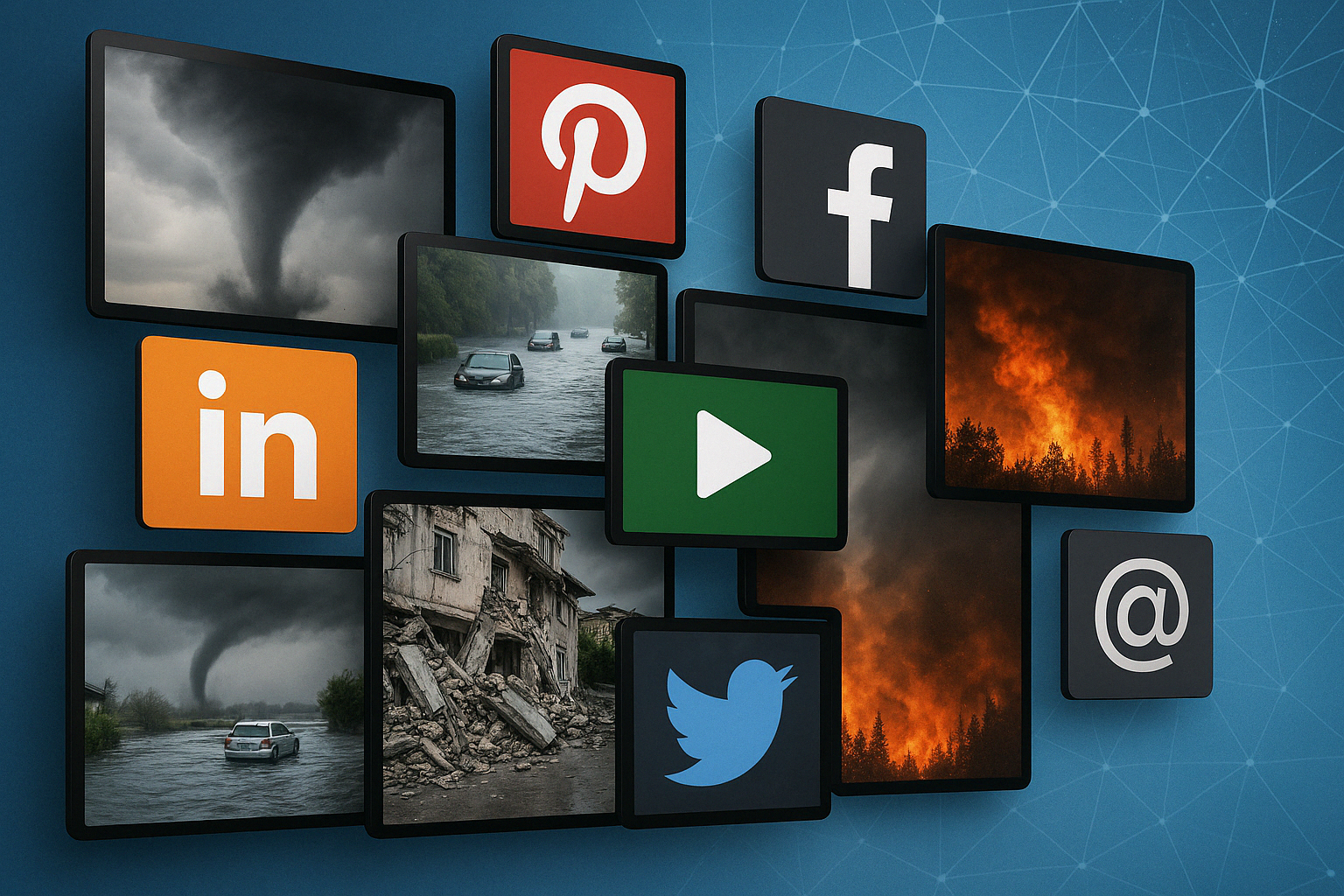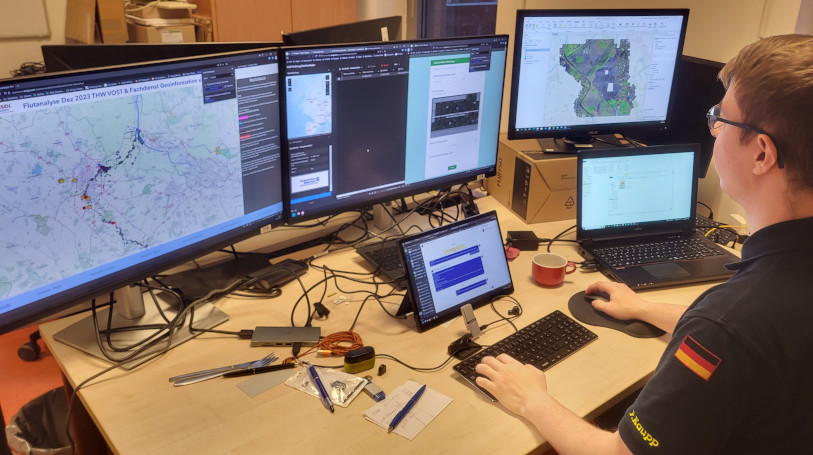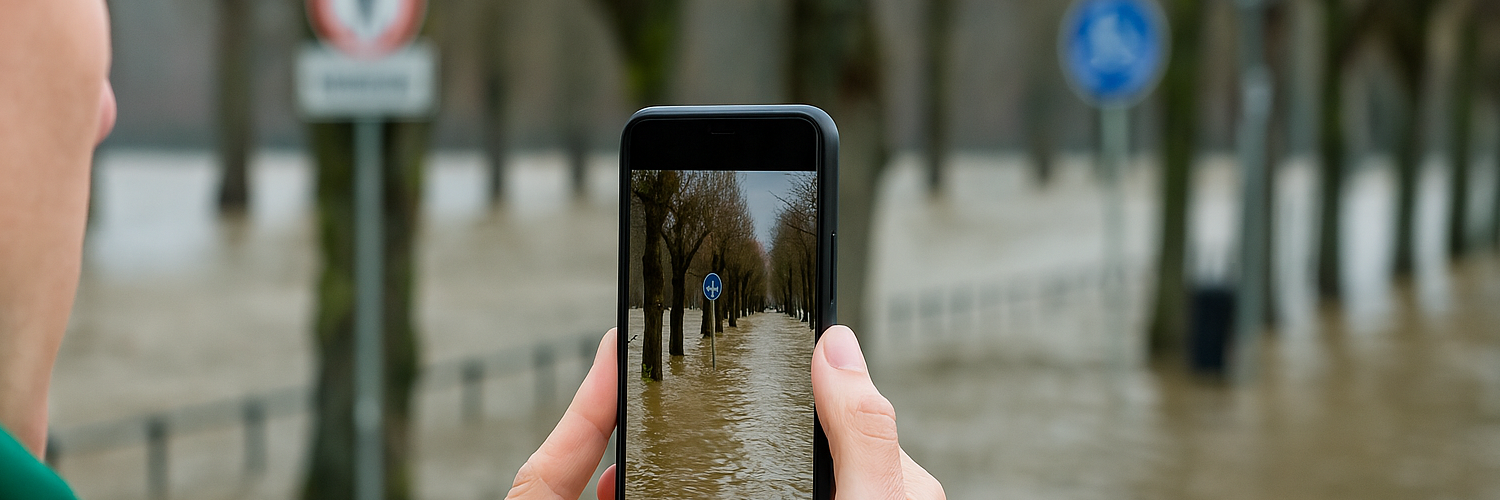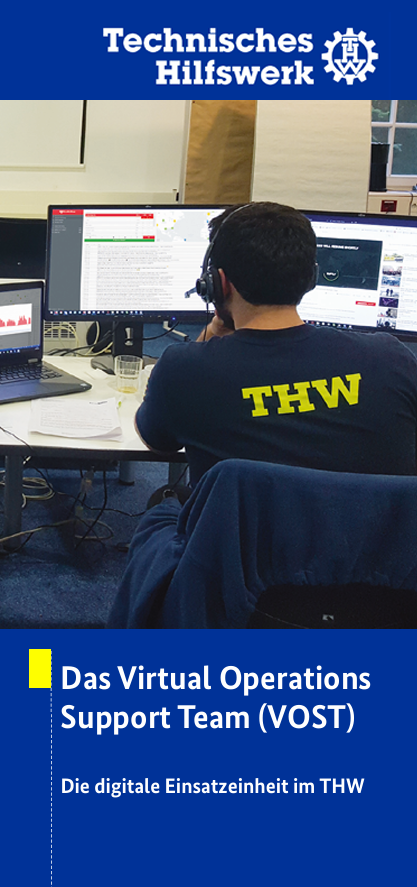Social Media in Civil Protection and Disaster Management
The digital transformation is increasingly shaping civil protection and changing communication, coordination and information flows in crisis situations. This topic page deals with opportunities, challenges and practical examples relating to the use of social media in crisis situations.
Digital Communication in Times of Change

Figure 1: Disasters in Social Media
The rapid digitalisation of society is also changing civil protection. Social media has long since become an integral part of everyday life – with far-reaching effects on communication, coordination and information processing in crises and disaster situations. Whether it’s heavy rain, a pandemic or a forest fire: X, Facebook, Instagram & Co. play an increasingly important role, both for Public Safety Authorities and Organizations (known in German as BOS – Behörden und Organisationen mit Sicherheitsaufgaben) and for the affected population.
Potential and Opportunities
Social media offers enormous potential for civil protection. Through functionalities such as the interactive design of information content, people on social media are no longer merely consumers of information. Thanks to low-threshold opportunities for participation, users become prosumers – both consumers and producers of information at the same time.
Speed
Information can be disseminated easily, rapidly, and globally in real time.
Reach
Millions of people can be reached instantly, with minimal technical barriers.
Low-threshold access
Usage is location-independent and often free of charge.
Interactivity
Feedback from the population provides valuable situational awareness.
Resilience building
Networking and digital communication enable the effective organization of self-help efforts (e.g., spontaneous volunteers) (Lülf & Fathi 2022).
Challenges and Risks
Social media is neither a panacea nor a threat – it is a reality. This was impressively demonstrated at the beginning of the Covid-19 pandemic in 2020. In addition to the pandemic, the WHO spoke of an infodemic, i.e. an overabundance of true and false information that accompanied the global fight against the pandemic and in some cases made it more difficult (WHO 2025).
For example, digitally produced false information that is disseminated at a low threshold can influence people’s practical actions with great reach and speed. In the case of attacks such as the one on 22 July 2016 at the Olympic Shopping Centre (OEZ) in Munich or on 20 December 2024 at a Christmas market in Magdeburg, it was observed that people reacted to so-called ‘phantom crime scenes’ – i.e. places without an actual crime – by fleeing and injuring themselves. These phantom crime scenes were partly influenced by false information in social media (Süddeutsche Zeitung 2017).
For emergency services, these risks mean increased analysis and verification efforts. A need that is met by innovative formats such as digital operational support units like the VOST THW.
Information overload
The relevance and quality of information are often difficult to assess.
Misinformation and disinformation
Rumors tend to spread particularly quickly during crises and disasters.
Data protection concerns
Publicly shared information may contain personal data.
Emotional strain
Images and videos from disaster areas can be psychologically distressing for users.
Best Practice: The Virtual Operations Support Team (VOST) of the THW
The Virtual Operations Support Team (VOST) of the Federal Agency for Technical Relief (THW) was established in 2016 and represents an outstanding example of the structured use of social media, open source intelligence (OSINT), and geoinformation systems in civil protection. As Germany’s first entirely volunteer-based digital unit in emergency response, it now consists of over 60 specialized volunteers. Through its virtual work in data analysis and visualization, VOST can be deployed rapidly both nationally and internationally – during floods, natural disasters, earthquakes, major public events, or pandemic situations.
The core tasks of VOST THW focus on two main areas: digital situational assessment and digital situational mapping. In digital situational assessment, publicly available information is systematically collected, verified, and contextualized for the operational setting. Digital situational mapping involves visualizing relevant data on digital maps, using tools such as Geographic Information Systems (GIS).
VOST is organized in a decentralized manner – its virtual responders work independently of location and are therefore largely resilient to local infrastructure failures. Through cooperation with other VOST entities, a robust network of digital support exists that can be activated quickly and flexibly when needed.
Crisis Communication and Social Media Strategies for BOS
Public safety authorities and organizations (known in German as BOS – Behörden und Organisationen mit Sicherheitsaufgaben) are increasingly faced with the challenge of adapting their public communication to the realities of the digital age. Beyond speed, a digital environment demands crisis communication that is as dialogue-oriented and human-centered as possible. If official social media accounts are used for public relations in everyday situations but fall silent during crises or disasters, this can lead to an information gap. For this reason, social media strategies have become particularly important for crisis communication. When used effectively, they can also be considered tactical tools in emergency response. In Germany, civil protection organizations generally enjoy a high level of public trust, providing a strong foundation upon which crisis communication efforts can build.
Key Principles:
- Platform-Appropriate Communication: Bureaucratic language often doesn’t work on social media. Clear, accessible, and citizen-friendly language is essential.
- Dialogue Orientation: Social media is not a one-way street. Engaging the public as an active part of the communication process is crucial.
- Speed: The “4-W strategy” at the onset of an event can create a valuable time advantage in communication (“We know, we do, we care, we’ll be back”).
- Transparency and Trust: Real-time communication builds credibility – as long as it is reliable and accurate.
Integration into Disaster Management
The integration of social media into disaster management opens up a wide range of opportunities, but also places complex demands on organisations and emergency services. In order to fully utilise its potential, up-to-date training and further education for emergency services are essential. A suitable technical infrastructure for systematically collecting and analysing data is also required. Social media should also be integrated as an integral part of the management process in accordance with FwDV 100. Crisis communication must also be further developed in order to utilise the specific dynamics of social media in a targeted manner. In the future, a modern ‘S2’ (Subject Area 2 – Situation) should also use data analysis and visualisation methods to improve situation assessment. Last but not least, legal issues relating to data protection, responsibilities and reporting obligations need to be clarified in order to ensure professional and legally compliant handling of social media in the event of a crisis.
Current Developments and Outlook
With the growing use of AI for data analysis, the deployment of drones and satellite imagery, and the establishment of international networks such as VOST Europe, the use of digital information channels in crisis management is becoming increasingly professionalized. At the same time, public awareness of the importance of digital resilience is growing. The goal must not only be to inform the population, but to actively involve them and harness their digital skills for civil protection. The key lies in a security architecture that is inclusive, participatory, and open to technological innovation.

Figure 3: Seeing through the Data Stream: the VOST at THW (©THW)

Figure 2: VOST at the European Men’s Football Championship 2024: Virtual disaster control (©THW)
Social media should not be seen as inherently a solution or a risk – regardless of how they are assessed, they are an indispensable part of modern life. For civil protection and emergency response, digital developments offer new opportunities that must be shaped responsibly and professionally to balance their potential and risks. Progressive units such as VOST THW clearly demonstrate that digital innovation and volunteer engagement can go hand in hand to make civil protection fit for the challenges of the 21st century.
Created: April 2025
Current Information
No Results Found
The page you requested could not be found. Try refining your search, or use the navigation above to locate the post.
Additional Information
Humanitäre Hilfe und Konzepte der digitalen Hilfeleistung
Fiedrich, F., Fathi, R. (2018). Humanitäre Hilfe und Konzepte der digitalen Hilfeleistung. In: Reuter, C. (eds) Sicherheitskritische Mensch-Computer-Interaktion. Springer Vieweg, Wiesbaden. https://doi.org/10.1007/978-3-658-19523-6_25
Soziale Medien in der Gefahrenabwehr
Lülf, M. & Fathi, R. (Herausgeber) (2022): Soziale Medien in der Gefahrenabwehr. Kohlhammer, Suttgart.



